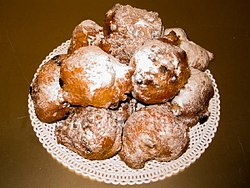Oliebol
 | |
| Type | Doughnut or dumpling |
|---|---|
| Place of origin | Netherlands |
| Main ingredients | Flour, eggs, yeast, some salt, milk, baking powder; usually sultanas, currants, raisins; zest or succade |
| Variations | Appelbeignet |
An oliebol (Template:IPA-nl, plural ⓘ) (also olykoek) is a traditional Dutch and Belgian food. They are called oliebollen (literally: oil spheres) in the Netherlands, while in Belgium they are also called smoutebollen (literally: lard balls although the real "smout" is of rapeseed oil) and croustillons (loosely: crispies) in French. In English they are more commonly known as Dutch Doughnuts or Dutchies. In the distant region of Istria, now split into the countries of Italy, Croatia and Slovenia, a variation of this dish is called fritole, fritule and blinci. In Serbia they are called uštipci.
Description
Oliebollen are a variety of dumpling made by using an ice cream scoop or two spoons to scoop a certain amount of dough and dropping the dough into a deep fryer filled with hot oil. In this way, a sphere-shaped oliebol emerges. Oliebollen are traditionally eaten on New Year's Eve[1] and at funfairs. In wintertime, they are also sold in the street at mobile stalls.
The dough is made from flour, eggs, yeast, some salt, milk, baking powder and usually sultanas, currants, raisins and sometimes zest or succade (candied fruit). A notable variety is the appelbeignet which contains only a slice of apple, but different from oliebollen, the dough should not rise for at least an hour. Oliebollen are usually served with powdered sugar.
In Flanders the "oliebol" is also called "smoutebol" because it is often cooked in animal fat rather than vegetable oil. Another difference between the Dutch oliebol and the Flemish smoutebol is that the smoutebol is usually not filled in contrast to the Dutch oliebol. The filling of the oliebol could consist of raisins, currants and apple, other ingredients can be added, such as succade, pieces of orange or whipped cream.
Origin
They are said to have been first eaten by Germanic tribes in the Netherlands during the Yule, the period between December 26 and January 6 where such baked goods were used [citation needed] . The Germanic goddess Perchta, together with evil spirits, would fly through the mid-winter sky. To appease these spirits, food was offered, much of which contained deep-fried dough. It was said Perchta would try to cut open the bellies of all she came across, but because of the fat in the oliebollen, her sword would slide off the body of whoever ate them. The earliest discovered recipe of oliekoecken ("oil cookies", the direct precursor of the oliebol) came from the 1667 Dutch book De verstandige kock "The smart/responsible cook".[2]
Variations
From oliekoek to oliebol

For centuries the Dutch ate oliekoek ("oil cookie"), an old name for oliebol ("oil ball"). The Oliebollen you see in the painting from around 1652 are very similar to today's oliebol. At that time, they were baked in lard or rapeseed oil. During the nineteenth century the word "oliebol" started to be used more. The 1868 edition of the Van Dale dictionary included word "oliebol", whereas the rival "Woordenboek der Nederlandsche taal" didn't include it until 1896, stating that "oliekoek" is a more commonly used term, but a major shift in usage occurred: from the early twentieth century the word "oliebol" became the popular word, while "oliekoek" was no longer in use.[3]
Croustillons
A very similar type of oliebol can also be found in the Walloon part of Belgium, Brussels and northern France. Croustillons are deep fried dough balls served hot and liberally sprinkled with powdered sugar. They are usually served in a paper cone with a little plastic fork to eat them with. They are typically found at fairgrounds in Belgium and in Lille, France.
Oliebollentest contest
Since 1993 Dutch newspaper Algemeen Dagblad has held an annual highly publicized oliebollentest at the end of each year. In 2012, the bakery of Willy Olink from Maarssen won the test.[4] In 2013 Richard Visser won the test for the ninth time in twenty years which is currently the record for the highest number of wins by one person.[5]
See also
- List of doughnut varieties
- Poffertjes
- Vetkoek
- Doughnut
- Fritter
- Æbleskiver, a similar Danish dish.
References
- ^ Sijs, Nicoline van der (2009). Cookies, Coleslaw, and Stoops: The Influence of Dutch on the North American Languages. Amsterdam UP. p. 135. ISBN 978-90-8964-124-3.
- ^ Oliebollen en oliekoeken Template:Nl icon
- ^ http://www.dictionary.com/wordoftheday/
- ^ "Visser opnieuw winnaar oliebollentest". NOS (in Dutch). December 27, 2011. Retrieved December 31, 2011.
- ^ "AD Oliebollentest 2013". Algemeen Dagblad. 2013. Retrieved 31 December 2013.
External links
 Media related to Oliebollen at Wikimedia Commons
Media related to Oliebollen at Wikimedia Commons

